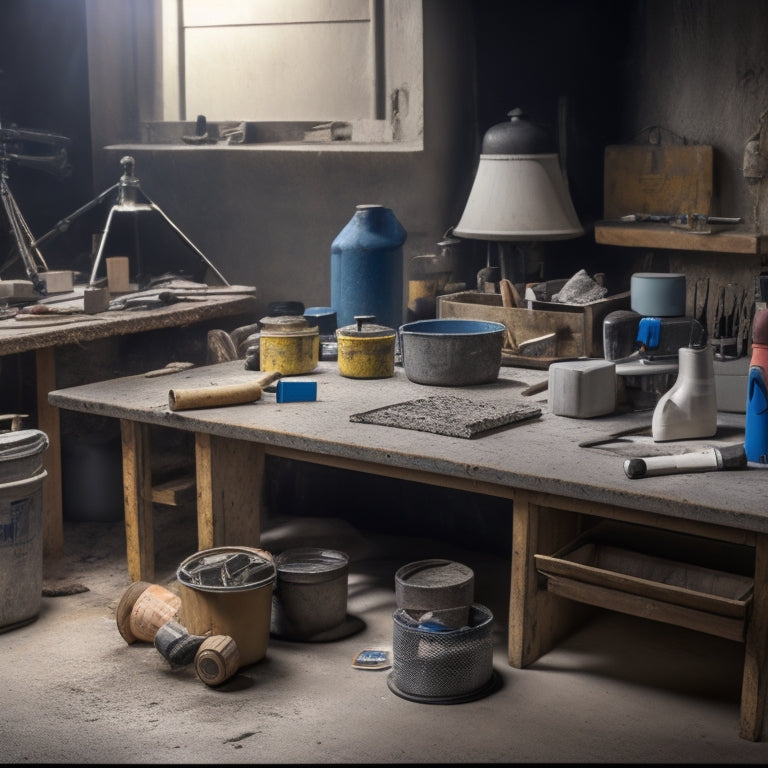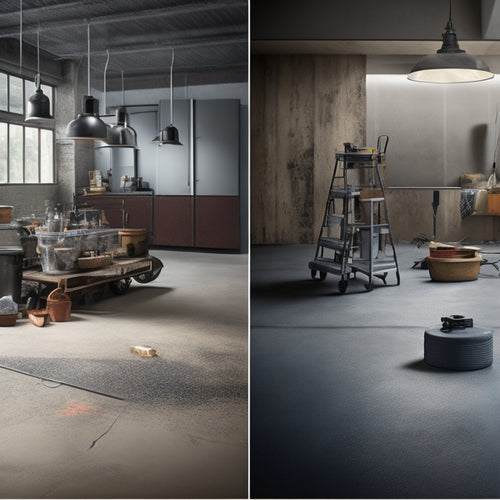
What Tools Do I Need for Concrete Sealing
Share
You'll need a range of tools and equipment to guarantee a successful concrete sealing project. Essential safety gear includes protective clothing, ventilation, and respiratory protection. For surface preparation, you'll need debris removal tools, surface cleaning techniques, and crack repair and filling tools. Sealant application equipment, such as applicator guns and spreader options, will also be necessary. Additionally, you'll require measuring and mixing tools, a pressure washer for cleaning, and additional accessories like microfiber applicators and cleaning solutions. To set yourself up for success, make certain you have all the necessary tools and equipment at your disposal - and get ready to master the art of concrete sealing.
Key Takeaways
- Essential safety gear includes protective clothing, ventilation, respiratory protection, and chemical-resistant gloves to ensure a safe working environment.
- Cleaning tools for surface preparation include brooms, leaf blowers, vacuum cleaners, and power washers to remove debris and clean the surface.
- Crack repair and filling tools involve crack identification, filling materials, and sealant application guns for precise control over sealant flow.
- Sealant application equipment includes applicator guns, equipment maintenance, and application techniques tailored to the type of sealant and project requirements.
- Additional accessories such as measuring and mixing tools, pressure washers, and microfiber applicators are necessary for a successful concrete sealing project.
Essential Safety Gear for Beginners
When working with concrete sealing tools, safety should always be your top priority, especially for beginners. You're dealing with harsh chemicals, heavy equipment, and physical labor, which can be hazardous if not handled properly. To guarantee a safe and successful project, you'll need to take essential safety precautions.
First and foremost, invest in protective clothing. You'll need a pair of gloves, safety glasses, and a face mask to shield yourself from chemical splashes and inhalation. A long-sleeved shirt, pants, and closed-toe shoes will also protect your skin from abrasions and cuts.
Don't forget a hat and a pair of steel-toed boots to complete your safety attire.
Additionally, make sure you're working in a well-ventilated area, away from open flames and sparks. Keep a fire extinguisher nearby and have a first-aid kit on hand in case of emergencies.
Cleaning Tools for Surface Prep
You'll need to remove debris, scrub the surface, and treat oil stains to guarantee a strong bond between the concrete and the sealant.
Effective debris removal methods, such as sweeping and blowing, will get rid of loose particles.
Next, you'll apply surface scrubbing techniques and oil stain treatment to create a clean, porous surface for sealing.
Debris Removal Methods
By the time you're ready to seal your concrete, the surface is likely to be littered with dirt, dust, and other debris that can interfere with the sealing process.
Effective debris removal is vital for a successful seal, as even the smallest particles can compromise the bond between the concrete and the sealant. You'll need to employ efficient debris collection techniques to guarantee a clean surface.
For large areas, a broom or a leaf blower can be used to remove loose debris. For more stubborn dirt and dust, a vacuum cleaner with a brush attachment can be effective. Additionally, a dustless vacuum or a HEPA-filter vacuum can be used to minimize dust particles in the air.
When it comes to surface preparation methods, a thorough cleaning strategy is essential. You may need to use a combination of these techniques to achieve a clean surface.
Surface Scrubbing Techniques
Get ready to tackle the toughest dirt and grime with surface scrubbing techniques, an essential step in preparing your concrete for sealing.
You'll need the right tools to effectively remove dirt, grime, and other substances that can compromise the sealant's adhesion. For general cleaning, a stiff-bristled broom or a power washer with a wide fan tip can be used to loosen debris.
For more stubborn stains, consider using a scrub brush or a scrub pad attached to a drill or grinder. These tools will help you remove dirt and grime without damaging the concrete surface.
When choosing a scrubbing technique, consider the type of dirt or stain you're dealing with and the level of aggression required. Always work in a well-ventilated area and wear protective gear, including gloves, safety glasses, and a dust mask.
Remember to rinse the surface thoroughly to prevent dirt and cleaning solution from interfering with the sealant.
Oil Stain Treatment
After scrubbing away dirt and grime, you may still be left with oil stains that require special attention. Oil stain removal is a vital step in preparing your concrete surface for sealing. Failure to adequately address these stains can lead to sealant failure and compromised durability.
To tackle oil stains, you'll need a few specialized tools. A degreaser or oil stain remover is important for breaking down and lifting the stain. Apply the product according to the manufacturer's instructions, allowing it to dwell for the recommended time before rinsing thoroughly.
For more stubborn stains, you may need to use a more aggressive treatment, such as a poultice or a stain-removing compound. Always follow the manufacturer's guidelines and take necessary safety precautions when working with these products.
Effective oil stain removal is critical not only for aesthetics but also for oil stain prevention in the long run. By removing the stain completely, you'll prevent it from seeping back through the sealant and reappearing.
Remember to always test a small, inconspicuous area first to verify the product you're using won't damage your concrete surface.
Crack Repair and Filling Tools
You'll need to identify cracks in the concrete before filling them, so you'll want to familiarize yourself with crack detection methods that suit your project's requirements.
Once you've located the cracks, you'll need to select the right filling material options to guarantee a strong, durable bond.
With the right materials in hand, you'll be ready to apply them using sealant application guns specifically designed for efficient, precise filling.
Crack Detection Methods
About 80% of concrete cracks are hidden from view, making crack detection a crucial step in the sealing process. You need to identify cracks before filling and sealing to guarantee a durable and long-lasting seal.
Crack detection methods help you locate and assess cracks, allowing you to develop an effective repair strategy.
You'll need to employ various techniques to detect cracks, including:
-
Visual Inspection Techniques: Conduct a thorough visual examination of the concrete surface, paying attention to signs of cracking, such as hairline cracks, spalls, or discoloration.
-
Acoustic Emission Methods: Use specialized equipment to detect the high-frequency sounds emitted by concrete as it cracks, allowing you to pinpoint crack locations.
-
Infrared Thermography: Utilize thermal imaging cameras to detect temperature anomalies on the concrete surface, which can indicate hidden cracks.
Filling Material Options
Your concrete sealing project's success hinges on selecting the right filling materials to repair cracks and restore structural integrity.
You'll need to choose from a range of options, each with its own strengths and weaknesses. Polyurethane-based fillers are popular for their flexibility and ability to expand and contract with the concrete.
Epoxy-based fillers, on the other hand, offer superior strength and durability. Acrylic-based fillers are another option, offering a balance between flexibility and strength.
When selecting a filling material, consider the size and depth of the crack, as well as the surrounding environment.
You'll also need to choose an application technique that suits the material and the crack. Injection methods, for example, are ideal for deep cracks, while trowel-applied fillers are better suited for surface-level repairs.
Sealant Application Guns
With the right filling material selected, it's time to focus on the tools that will help you apply it efficiently and effectively.
Sealant application guns are essential for achieving a successful concrete seal. These guns come in various types, each designed for specific sealant types and application techniques.
When choosing a sealant application gun, consider the following key factors:
-
Pressure output: Select a gun that can handle the pressure required for your chosen sealant type. Higher-pressure guns are suitable for thicker sealants, while lower-pressure guns work better with thinner ones.
-
Material handling: Verify the gun can handle the viscosity and flow rate of your sealant. Some guns are designed for high-flow materials, while others are better suited for low-flow applications.
-
Precision control: Opt for a gun that provides precise control over the sealant flow, allowing you to accurately fill cracks and joints.
Sealant Application Equipment Needed
Selecting the right sealant application equipment is essential to achieving a successful concrete sealing project. You'll need to take into account the type of sealant you're using and the application technique you've chosen.
For example, if you're working with a solvent-based sealant, you'll need equipment that can handle the solvent's viscosity and flow rate. On the other hand, if you're using a water-based sealant, you'll need equipment that can handle the lower viscosity and higher flow rate.
When choosing application equipment, think about the size of your project and the surface area you need to cover. You may need a larger capacity tank or a more powerful pump to guarantee consistent application.
Additionally, reflect on the type of substrate you're working with. For instance, if you're sealing a rough, porous surface, you may need equipment that can handle thicker sealant applications.
Remember to also take into account the temperature and humidity of your work environment, as these factors can affect the performance of your equipment and the sealant itself.
Spreader and Squeegee Options
You'll need to choose the right squeegee blade type for your concrete sealing project, as it affects the quality of the sealant application.
You'll have options like rubber, neoprene, or polyurethane blades, each suited for specific sealant types and surface conditions.
Additionally, you'll want to take into account the spreader handle options, such as adjustable or fixed handles, to guarantee a comfortable and efficient application process.
Squeegee Blade Types
When it comes to applying concrete sealers, having the right squeegee blade type is essential for achieving an even, consistent coat.
You'll want to choose a squeegee that effectively pushes the sealer onto the concrete surface without leaving behind streaks or marks.
You have several options for squeegee material types:
-
Rubber: A popular choice for concrete sealing, rubber squeegees are flexible and gentle on the surface. They're ideal for applying solvent-based sealers and come in various durometers (hardness levels) to suit your needs.
-
Foam: Foam squeegees are lightweight and easy to maneuver, making them perfect for large areas or intricate spaces. They're often used with water-based sealers and are less likely to leave behind streaks.
-
Notched: Notched squeegees feature a series of small notches or grooves along the blade, which help to distribute the sealer evenly. They're great for applying thicker, more viscous sealers and work well with both solvent-based and water-based products.
Remember to select a squeegee size that matches your project's requirements, taking into account the area you need to cover and the type of sealer you're using.
Spreader Handle Options
With your squeegee blade type chosen, it's time to reflect on the handle that will give you the control and leverage you need to apply the sealer effectively.
You have two primary manual spreader options to take into account: fixed and adjustable handle types. Fixed handles are typically lightweight, inexpensive, and suitable for smaller projects. However, they may lack the versatility you need for larger or more complex applications.
Adjustable handle features allow you to customize the spreader to your specific needs. These handles often come with telescoping or pivoting capabilities, enabling you to reach tight spaces, navigate curves, and maintain a comfortable working position.
This adaptability can greatly reduce fatigue and improve overall efficiency. When selecting an adjustable handle, look for durable materials, smooth adjusting mechanisms, and secure locking systems to guarantee a reliable and consistent application process.
Roller Extension Poles Required
Across the expanse of your concrete sealing project, an essential component stands out: the roller extension pole. This tool allows you to efficiently apply sealer to large areas without straining your back or wasting time.
When selecting a roller extension pole, consider the following factors:
-
Roller types: Choose between microfiber, foam, or lambswool rollers, each suited for specific sealer types and concrete surfaces.
-
Extension lengths: Select poles that can extend from 4 to 12 feet, allowing you to reach high areas and corners with ease.
-
Pole material: Opt for durable, lightweight materials like fiberglass or aluminum, which provide stability and reduce fatigue.
Pressure Washer for Cleaning
You've sealed your concrete, but before applying a new coat, you need to clean the surface thoroughly. A pressure washer is an essential tool for this task, and there are several types to choose from.
Electric pressure washers are ideal for small to medium-sized areas and are generally more affordable. Gas-powered pressure washers, on the other hand, are better suited for larger areas and offer more power.
When selecting a pressure washer, consider the pressure rating (measured in pounds per square inch, or PSI) and the flow rate (measured in gallons per minute, or GPM). A higher PSI and GPM will provide more effective cleaning.
To guarantee peak performance, regular pressure washer maintenance is vital. Check the nozzle and hose for damage or blockages, and clean or replace them as needed.
Also, make sure to drain the fuel tank and run the pump with a cleaning solution to prevent corrosion. Finally, store the pressure washer in a dry, protected area to prevent damage from the elements.
Measuring and Mixing Tools
Accurate measurements and thorough mixing are essential steps in achieving a successful concrete seal. You'll need the right tools to guarantee the job is done correctly.
To measure and mix your concrete sealer, you'll need:
-
Measuring containers: These can be measuring cups, buckets, or containers specifically designed for mixing concrete sealers. Make sure they're clean, dry, and free of contaminants.
-
Mixing sticks or paddles: These tools will help you mix the sealer to the correct consistency, guaranteeing a uniform application.
-
Scale or calculator: Accurate mixing ratios are vital. Use a scale or calculator to confirm you're mixing the correct proportions of sealer to solvent.
When measuring, always follow the manufacturer's instructions for mixing ratios. Never guess or estimate, as this can lead to a subpar seal.
Take your time, and double-check your measurements to guarantee a successful application. With the right measuring and mixing tools, you'll be well on your way to a beautifully sealed concrete surface.
Protective Mask and Gloves
Now that you've prepared your concrete sealer with the right measuring and mixing tools, it's time to focus on your personal safety. A protective mask and gloves are vital components of your concrete sealing toolkit, providing significant safety benefits during the application process.
When it comes to masks, opt for a respirator with a filter designed specifically for organic vapors. This will guarantee you're protected from inhaling harmful fumes emitted by the sealer.
Make sure to follow the manufacturer's instructions for proper usage, including fitting and maintenance.
Gloves are equally important, as they'll shield your skin from harsh chemicals and stains. Choose gloves made from a durable, chemical-resistant material like nitrile or neoprene.
Confirm a snug fit to prevent chemicals from seeping in. Always follow the manufacturer's guidelines for proper usage, including disposal and cleaning.
Additional Accessories for Success
Frequently, even the most meticulous concrete sealing projects can benefit from additional accessories that enhance efficiency and quality.
These accessories can make a significant difference in the outcome of your project, saving you time and guaranteeing a professional finish.
To take your concrete sealing project to the next level, consider the following accessories:
-
Extension poles: These allow you to reach high areas or cover large surfaces without straining your back or using ladders. They're especially useful for applying sealers to vertical surfaces or high ceilings.
-
Microfiber applicators: These absorbent pads are designed for even, streak-free application of sealers. They're ideal for applying sealers to smooth surfaces, such as polished concrete or epoxy-coated floors.
-
Cleaning solutions and rags: Having a dedicated cleaning solution and rags on hand guarantees you can quickly remove spills, clean your tools, and maintain a tidy workspace.
This attention to detail is essential for achieving a flawless finish and mastering application techniques.
Frequently Asked Questions
Can I Use a Regular Broom to Sweep the Concrete Surface?
You can't use just any broom for surface preparation; a stiff-bristled broom or a push broom with synthetic bristles is ideal for sweeping the concrete surface, ensuring effective dirt removal and a smooth sealant application.
How Long Does It Take for Sealant to Fully Dry and Cure?
You'll need to wait patiently for the sealant's drying time, typically 24-48 hours, before it fully cures, a process that can take up to 30 days, depending on environmental factors and the type of sealant you're using.
Can I Apply Sealant in Direct Sunlight or High Winds?
Don't get burned by bad timing! You'll want to avoid applying sealant in direct sunlight or high winds, opting instead for overcast skies and gentle breezes – the best weather conditions for a successful application.
Is It Necessary to Seal All Concrete Surfaces, Including Indoor Floors?
You're wondering if sealing indoor concrete floors is necessary; the answer is yes, as it protects them from stains, cracks, and damage, while also enhancing their appearance and extending their lifespan, providing numerous sealing benefits.
Can I Reuse Leftover Sealant From a Previous Project?
Are you tempted to revive that leftover sealant from a previous project? Don't fall into that trap! Proper sealant storage is key, and reusing old sealant can compromise its performance, so it's best to start fresh with a new batch.
Conclusion
You've made it to the finish line! Sealing your concrete is a marathon, not a sprint, and having the right tools is your winning strategy. With your arsenal of safety gear, cleaning tools, crack repair materials, and sealant application equipment, you're ready to cross the finish line with a beautifully sealed concrete surface that's as smooth as a baby's bottom. Now, get out there and seal like a pro!
Related Posts
-

Essential Tools for Painting Concrete Walls
When painting concrete walls, you'll need a range of specialized tools to achieve a professional-looking finish. Star...
-

Top Concrete Resurfacing Tools for a Pro Finish
When it comes to achieving a professional finish in concrete resurfacing projects, you require the right set of speci...
-

Top Tools for Revamping Old Concrete Floors
You'll need a range of tools to revamp your old concrete floor, starting with epoxy, acrylic, or polyurethane paint, ...


